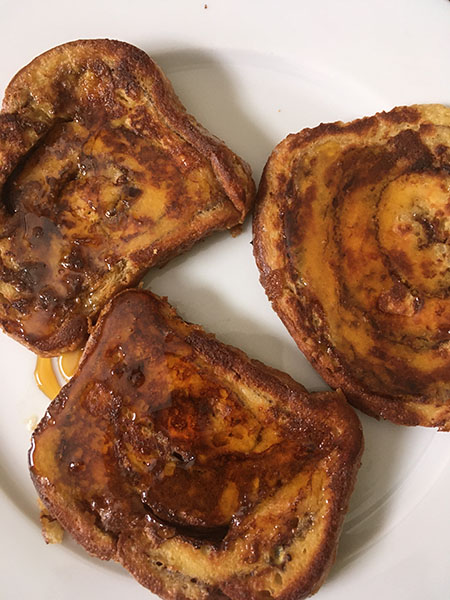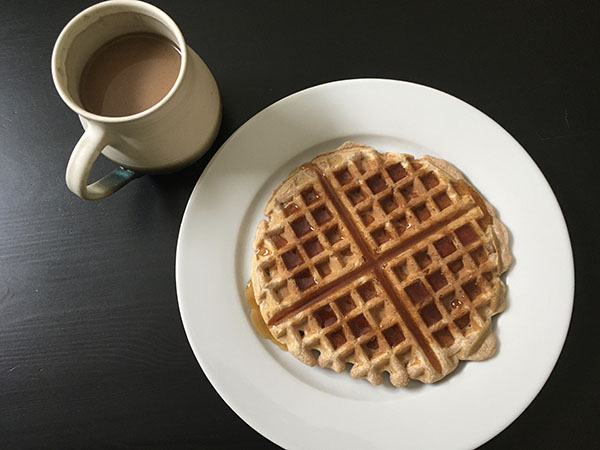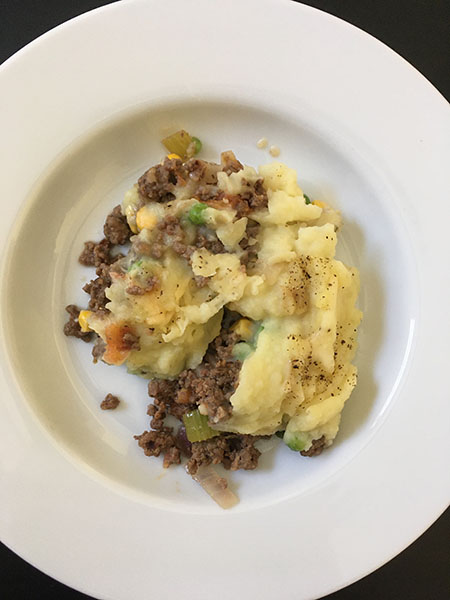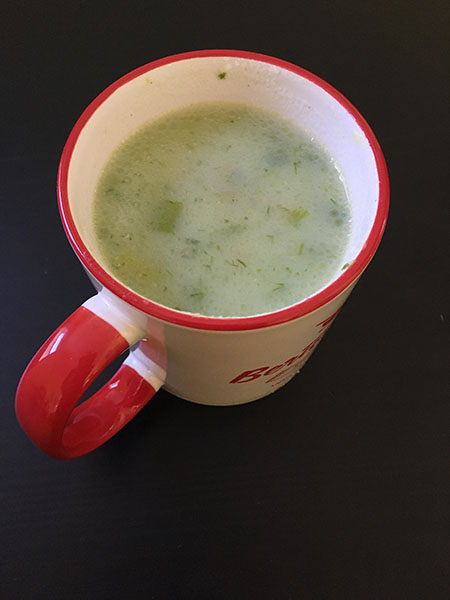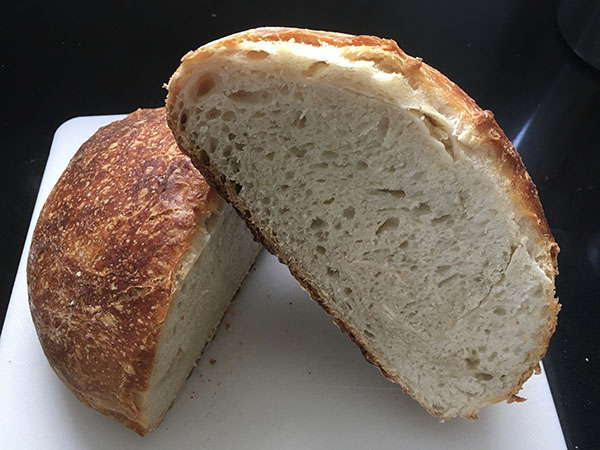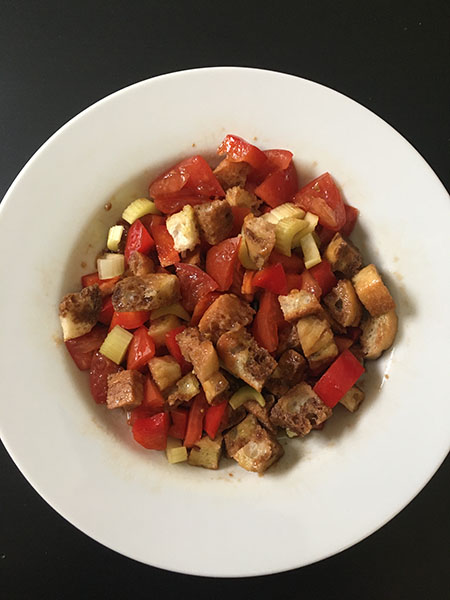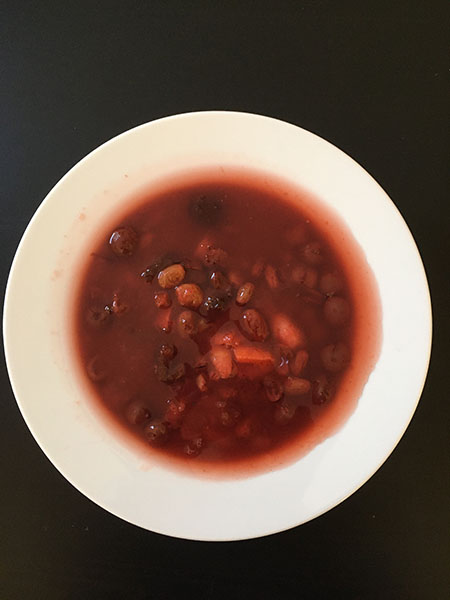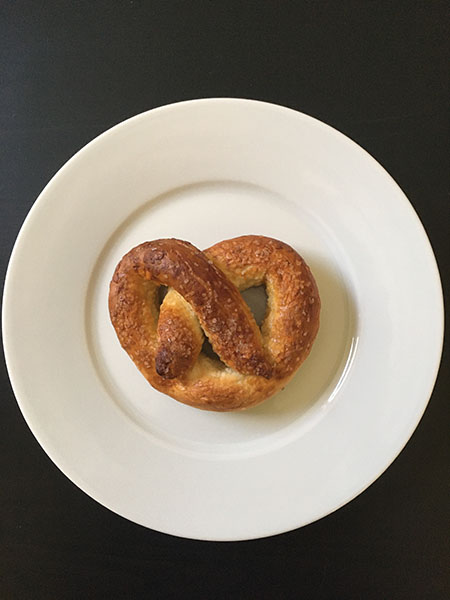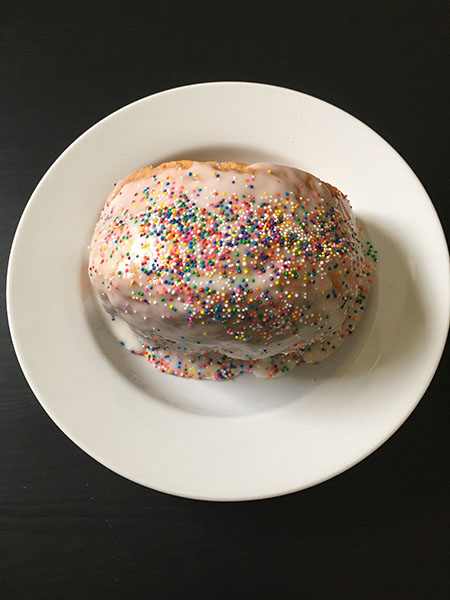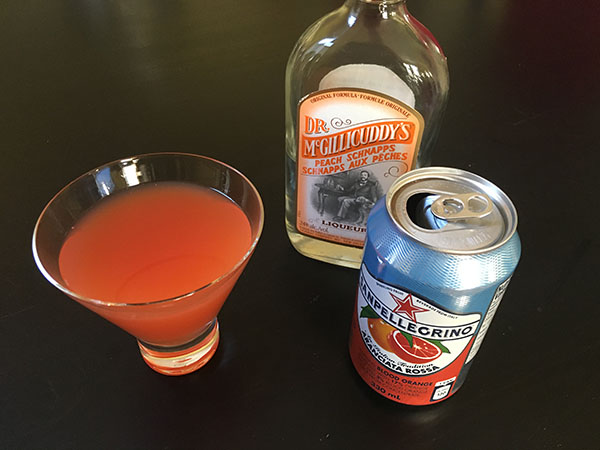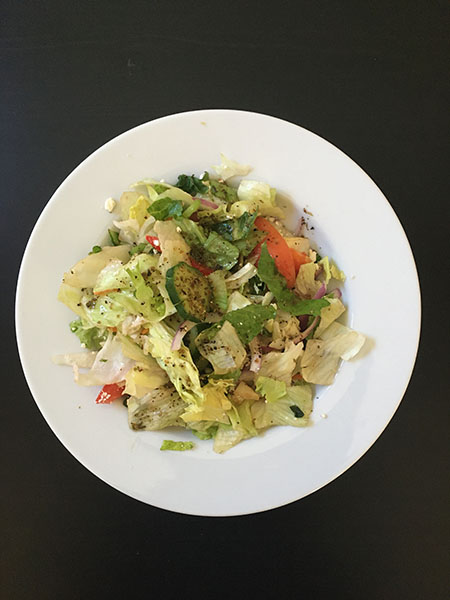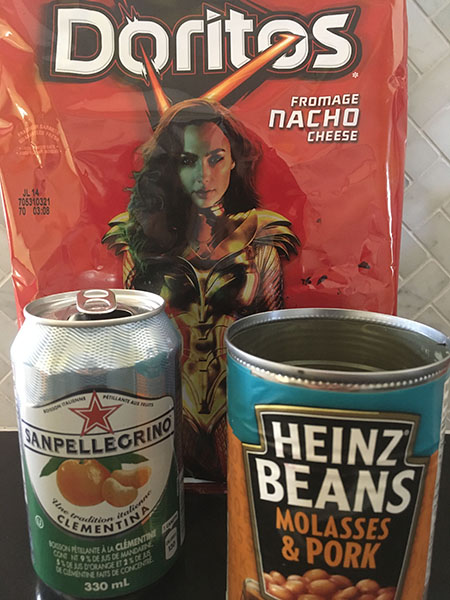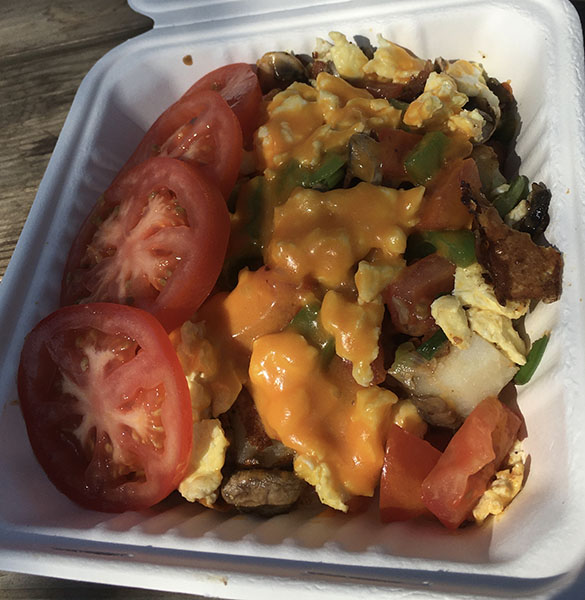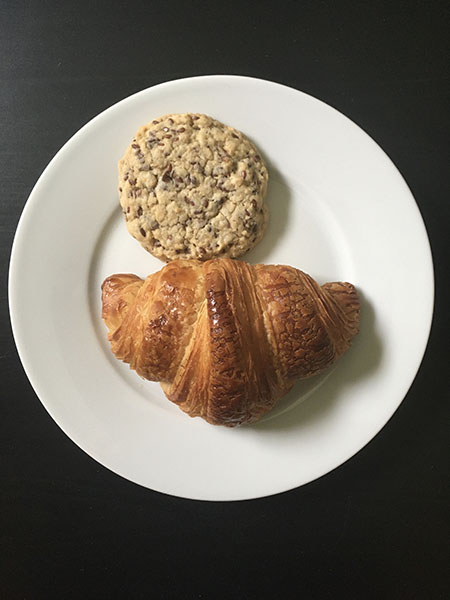Article body
What is it like to be forced to cook when you hate to cook but restaurants are closed due to a global pandemic?
Perhaps I inherited my dislike of cooking. My mother tells me she rejected my father’s marriage proposal multiple times, finally telling him “I don’t want to cook for you.” His insistence that he wanted a wife, not a cook, led to their wedding. Because of the nature of their employment, she was nonetheless the main provider of meals in my childhood home until my teens. Money was tight, and I have memories of the jam bunwiches she would send with us to school: homemade buns (delicious if freshly made, freezer-burned otherwise) with an almost invisible layer of homemade jam. Their dryness made them a chore to eat. She made excellent soups, though: her cabbage borscht (heavily dilled) and green bean soup (with summer savory) were delicious. She cooked some favourites of my dad’s, despite their questionable nature: pork chops, fried so long that they curled in the pan, served with a layer of Bick’s green hot dog relish to rehydrate them. But other favourites of his that she personally hated she would refuse to cook. As a result, I learned to make “summer borscht” from my dad. Summer borscht takes advantage of the early appearance of the bitter weed sorrel in spring. Its only ingredients are water, butter, onion, potatoes, farmer sausage – and huge quantities of sorrel.
My dad took over cooking when he became a full-time textbook author, working from home, and mom found paid employment outside the home. He would write until mid-afternoon, when he would come upstairs from his basement office to watch Wok with Yan on TV.[1] We only occasionally ate at restaurants, due to the expense, but as prairie inhabitants we were familiar with Chinese Canadian food. The show inspired him to attempt some of Martin Yan’s recipes, modified to make use of whatever ingredients were readily available in our Russian Mennonite kitchen. Minute steak, onions, and mushrooms, diced and fried with hoisin and oyster sauce and served over instant white rice, became a staple. Other stir fries (cooked in a frying pan since we had no wok) were less popular in our household, as he would toss in peas, carrots, corn and whatever else was lingering in the fridge.
When I first moved away from home, my diet consisted of some favourite meals of my childhood. Fried potatoes and eggs, eaten with diced raw onion or slices of Klik luncheon meat drowned in vinegar (my dad would have substituted frozen uncooked farmer’s sausage for the Klik). Cans of Heinz spaghetti or baked beans. Hungry Man frozen dinners of Salisbury steak. Macaroni with my dad’s version of Marcella Hazan’s classic tomato sauce: diced onions fried in butter, a jar of home-canned tomatoes, a splash of vinegar, a teaspoon of white sugar, and dashes of ketchup and bottled chili sauce.
As my income increased and my available time decreased, I was able to outsource the chore of regularly feeding myself. For the last twenty years, I’ve lived in a downtown neighbourhood with a large variety of local independent restaurants. Restaurant food on a regular basis was finally affordable for me, and I took advantage of the many Vietnamese, Chinese, Italian, Greek, Mexican, and Indigenous offerings nearby. I got almost all of my lunches from Diversity Foods, the social enterprise that operates food services on my university campus, and most dinners from restaurants on my walk home. I ate well.
On March 20, 2020, to combat the spread of the COVID-19 virus, my university closed and we began to work from home. That day, Manitoba declared a state of emergency, and severe restrictions on operation were imposed on restaurants in Manitoba.[2] Many closed in response. It would be many weeks and months before some (but not all) of my favourite restaurants were able to pivot to takeout, before knowledge increased of how COVID-19 spread, before Manitobans “flattened the curve” (however temporarily) and I felt comfortable visiting restaurants again.
In the interim, I was forced to cook for myself with a regularity I hadn’t had to since I first moved away from home. I began posting some of my cooking attempts on twitter, using the hashtag #COVIDcooking, as a way of dealing emotionally with the change in my personal circumstances.
MARCH 22-27 — Prepared some easy meals: French toast, coddled eggs, waffles, pasta. Got takeout delivered by my niece from a local Danish restaurant. I enjoy cooking as a rare event, not as a way of being regularly fed.
Figure 1
Figure 2
Figure 3
Figure 4
Figure 5
Figure 6
MARCH 28 — Shepherd’s pie is one of my favourite foods, but I’ve never made it until today because it always seemed like too much work. But I discovered that one of the attachments for the stick blender I inherited from my grandma (who died 40 years ago) is a ricer! Wish I’d known this decades ago; I could have been eating mashed potatoes at home all this time.
Figure 7
MARCH 29 — Turns out vichyssoise is the cold version of a classic hot soup from my Mennonite ethnic tradition, known as “butter soup”: water, onions, potatoes, butter, milk. Delicious.
Figure 8
APRIL 1 — Marcella Hazan’s three-ingredient tomato sauce is all over my twitter timeline, so I decide to make some. The flavour is familiar — it’s like my dad’s spaghetti sauce, minus the sugar, vinegar, ketchup, and chili sauce he used to doctor it with. Yum.
Figure 9
APRIL 1 — I’ve never had success with pasta salad. But using orzo instead of macaroni, and olive oil & balsamic vinegar instead of bottled Italian dressing, makes all the difference.
Figure 10
APRIL 6 — Everyone on twitter is baking pandemic bread. I don’t care for bread very much, and certainly don’t like sourdough. But I have a Dutch oven and had some fresh yeast delivered, so I might as well give it a try. Meh.
Figure 11
Figure 12
APRIL 9 — Panzanella is a new (to me) recipe I learned last summer. I do like fresh baguette, but it’s too much for one person to eat before it goes stale. This is a tasty way to use it up.
Figure 13
APRIL 10-11 — My family is not gathering for Easter, to help slow the spread of COVID. My married siblings each independently drop off some homemade food at my house so I can celebrate alone. Sister Val leaves some pluma moos, a cold fruit soup from our Russian Mennonite tradition. Sister Tanis leaves half a paska, a Mennonite twist on the Easter bread my ancestors learned from their Ukrainian neighbours – icing and sprinkles are mandatory. Brother Tim leaves me a pretzel; he’s been experimenting with baking as well. Love these tasty expressions of love from the family I haven’t seen — even at a distance — in weeks.
Figure 14
Figure 15
Figure 16
APRIL 16 — It’s been almost a month of working from home. Time for pandemic cocktails. I’ve had Amarena and Luxardo cherries delivered, and so am also making old fashioneds and negronis. Ina Garten and Stanley Tucci feel the same way, apparently.[3]
Figure 17
MAY 2 — Takeout day! Enough with the cooking. My sister Val drops off a buzzburger from a favourite drive-in an hour-and-a-half away from my home in the town where my grandparents used to live. And I get some Greek salad from a classic Winnipeg diner.
Figure 18
Figure 19
MAY 15 — Long weekend laziness.
Figure 20
MAY 17 — Phase 1 of reopening in Manitoba began May 4, and phase 2 is scheduled for June 1.[4] So I visit a restaurant patio for a meal for the first time, and dream of the pre-pandemic days when I used to out-source most of my cooking.
Figure 21
MAY 26 — One of my favourite local bakeries has reopened. Small signs of normalcy.
Figure 22
JUNE 5 — Indoor restaurant dining (with distancing and restricted capacity) became possible a few days ago. Time for eggs benedict, indoors, at one of my favourite local breakfast spots. Who knows how long this will last before restrictions are tightened again.
Figure 23
It didn’t last long, sadly. Manitoba entered the second wave of the pandemic that fall. All social gatherings were prohibited, and restaurants were closed except for takeout, delivery, and drive-thru orders.[5] It would be a long, lonely winter… but I had more cooking skills and I’d succumbed to the allure of food delivery apps. And there was much for which to be grateful: my family remained relatively healthy and employed (so many in Manitoba are not), my father is not alive to deal with these difficult days, and my aged mother moved to a care home (some of which had been scandalously ravaged by the pandemic) only after having been double vaccinated.[6]
In the face of the astonishingly high case counts and the many needless deaths of the province’s second wave, my #COVIDcooking twitter diary seems frivolous. But as my research collaborator Kimberley Moore reminds me,
It’s not frivolous — it’s a coping mechanism. It’s thematically similar to your work, but it is not your work. It is something different… The fact that academics are doing these things doesn’t make them more or less important than any non-academic’s documenting their sourdough attempts, or rebooted home renovation efforts, or chronicling of neighbourhood landscapes on daily walks.[7]
Attempts to preserve and continue with those aspects of an earlier life that we find meaningful are necessary. We record them, for ourselves and others, however ephemerally, to maintain our sense of community. We do so not for the historical record or for our careers, but for our survival.
There were many funding and publishing opportunities for academics the summer of 2020 to research the social impact of COVID. I was asked how the Manitoba Food History Project’s goals would change in light of COVID (they didn’t),[8] and whether I would participate in academic blogs that documented home cooking during COVID (I didn’t). Some of these academic efforts were admirable, taking advantage of professional expertise in the histories of health, crisis, and trauma. Some of them seemed opportunistic, pivoting research agendas to the latest avenue for funding and media attention. I’m not a historian of health. And I didn’t want to be an opportunist. But I did tweet… in an attempt to communicate with someone, anyone, when I was seeing no one.
Our research on the Manitoba Food History Project mattered before COVID, and COVID doesn’t diminish its value. There are academics with expertise in medical history or trauma-informed interviewing, and archivists are working to collect and preserve records of COVID experiences; we can trust these people to do this useful and necessary work. My #COVIDcooking series of tweets stems not from my work as an academic, but my life as a person, living alone (and sometimes afraid) during a global pandemic.
In times of upheaval, we all crave community — even more so when our usual venues for maintaining community connections are disrupted. After a devastating third wave in spring 2021, restaurants were permitted to reopen with 25% indoor occupancy on June 30.[9] The future of many independent local restaurants, so important to my daily life, nonetheless remains uncertain. What is certain, however, is that we all need to find personal coping strategies during these times. Some will cope by cooking. Some by eating our favourite comfort foods. And some of us, by tweeting into the void.
Appendices
Biographical note
Janis Thiessen is Professor of History at the University of Winnipeg, and the principal investigator for the Manitoba Food History Project. She does not like to cook.
Notes
-
[1]
“Wok with Yan first aired on CBC in 1980. M. Gale Smith, “Wok with Stephen Yan,” BC Food History, https://bcfoodhistory.ca/wok-with-stephen-yan/; Anu Sahota, “You Are Wok You Eat,” CBC (23 May 2007), https://www.cbc.ca/asianheritage/2007/05/wok_a_delight.html."
-
[2]
Government of Manitoba, “Manitoba government declares state of emergency to protect the public, reduce spread of COVID-19” (March 20, 2020), https://news.gov.mb.ca/news/?archive=&item=47137.
-
[3]
Ina Garten, Instagram post (April 1, 2020), https://www.instagram.com/tv/B-cJUwUpxbM/; Stanley Tucci, Instagram post (April 20, 2020), https://www.instagram.com/tv/B_NkcbTgVfy/.
-
[4]
Government of Manitoba, “Premier unveils Manitoba’s roadmap to expanding services safely” (April 29, 2020), https://news.gov.mb.ca/news/?archive=&item=47664; Government of Manitoba, “Second phase of restoring safe services plan to begin June 1” (May 27, 2020), https://news.gov.mb.ca/news/?archive=&item=48325.
-
[5]
Bartley Kives, “1 year into the pandemic, Manitoba has Canada’s 2nd-worst coronavirus death rate,” CBC Manitoba (11 March 2021), https://www.cbc.ca/news/canada/manitoba/manitoba-coronavirus-deaths-cases-tests-hospitalizations-pandemic-anniversary-1.5943323; Government of Manitoba, “All of Manitoba moves to critical (red) on #RestartMB pandemic response system” (10 November 2020), https://news.gov.mb.ca/news/?archive=&item=49737.
-
[6]
Joyanne Pursaga, “Maples care home situation ‘sickening,’ province should consider asking for military help, mayor says,” Winnipeg Free Press (November 9, 2020), https://www.winnipegfreepress.com/special/coronavirus/maples-care-home-situation-sickening-province-should-consider-asking-for-military-help-mayor-says-573017141.html#cxrecs_s; Dylan Robertson, “Trudeau ‘deeply concerned’ about care home deaths,” Winnipeg Free Press (November 9, 2020), https://www.winnipegfreepress.com/special/coronavirus/trudeau-deeply-concerned-about-care-home-deaths-573023301.html; Melissa Martin, “‘All these people are helpless’,” Winnipeg Free Press (November 8, 2020), https://www.winnipegfreepress.com/special/coronavirus/all-these-people-are-helpless-573011221.html.
-
[7]
Personal correspondence.
-
[8]
University of Winnipeg, “Manitoba Food History project trucking along remotely” (28 May 2020), https://news.uwinnipeg.ca/manitoba-food-history-project-trucking-along-remotely/.
-
[9]
Government of Manitoba, “COVID-19 Novel Coronavirus: Race, Ethnicity, Indigeneity (REI) Analysis Wave Three” (5 July 2021), https://www.gov.mb.ca/health/publichealth/surveillance/docs/rei_analysis_w3.pdf; Government of Manitoba, “COVID-19 Prevention Orders under The Public Health Act (CCSM c.P210)” (30 June 2021), https://manitoba.ca/asset_library/en/proactive/20212022/orders-soe-06302021.pdf.
Appendices
Note biographique
Janis Thiessen est professeure d’histoire à l’Université de Winnipeg et la chercheuse principale du projet Manitoba Food History Project. Elle n’aime pas cuisiner.
List of figures
Figure 1
Figure 2
Figure 3
Figure 4
Figure 5
Figure 6
Figure 7
Figure 8
Figure 9
Figure 10
Figure 11
Figure 12
Figure 13
Figure 14
Figure 15
Figure 16
Figure 17
Figure 18
Figure 19
Figure 20
Figure 21
Figure 22
Figure 23


